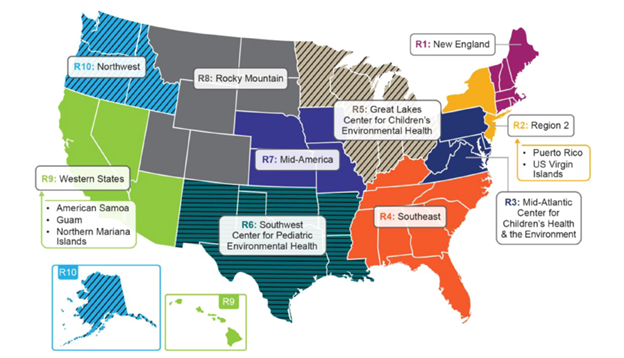Pediatric Environmental Health Specialty Units
The Pediatric Environmental Health Specialty Units, or PEHSU, are a network of pediatricians, nurses, health educators and other health professionals with expertise in children’s health issues related to environmental exposures, from preconception through adolescence.
Purpose of the PEHSU
For over 25 years, the PEHSU have helped children and families across the nation by addressing the health impacts of environmental exposures. The PEHSU are an important resource, not only for healthcare providers, but also for the public. From prevention to diagnosis, management, and treatment, the PEHSU are ready to respond to a wide range of environmental health questions.
PEHSU experts are trained to look at how things in the environment might be affecting children’s health. Without this specialty training, caregivers and health professionals might not recognize when a child’s health issues are linked to something in their environment.
PEHSU work with and support a number of partners vital to children’s environmental health:
- Clinicians – pediatric and obstetric
- Public health, environmental officials, and housing agencies – federal, state, local
- School administrators
- Child care center directors
- Community members and parents
PEHSU Mission
The PEHSU mission falls under three main areas:
- Community education and outreach
- Raise awareness about environmental health issues
- Offer guidance to prevent or reduce exposures
- Provide practical advice to help children cope and recover
- Consultation and Referral
- Evaluate suspected toxic exposure
- Identify and interpret diagnostic tests
- Provide referrals to specialty care
- Training health professionals
- Includes pediatricians, nurses, toxicologists, public health practitioners, and others through fellowships, grand rounds, lectures, and healthcare professional education courses
Where the PEHSU are Located
PEHSU are located in each of EPA’s 10 regions and are usually associated with universities or academic health centers. PEHSU locations in each region focus and specialize in local environmental health issues. For example, some PEHSU have expertise on wildfire smoke impacts, while others are experts in lead exposures. The PEHSU network supports each PEHSU unit in sharing their expertise with each other and with their communities.

EPA’s Role with the PEHSU
The Agency for Toxic and Disease Registry (ATSDR) and EPA partner to provide funding for the PEHSU network to operate. ATSDR owns and manages the grant that makes the PEHSU possible and EPA provides critical support. In addition, EPA’s regional children’s health coordinators work closely with the PEHSU in their region to address children’s environmental health issues of most concern in their communities. EPA and ATSDR also work closely to promote the work of the PEHSU to external partners and the general public.
